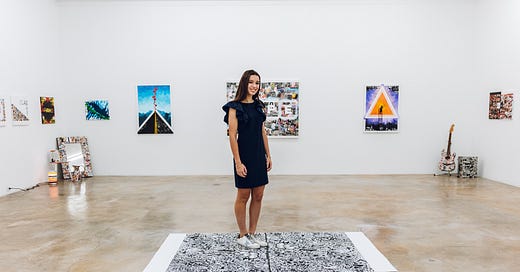The Creative Capitalist: The Impetus.
If creativity is a currency, I’m investing—and here’s why you should, too.
Growing up, creativity meant making things: coloring outside the lines, experimenting with art supplies, or sketching a yearbook cover for my eighth-grade class. If I was creating something, I was being creative. Creativity was in the making.
Then, as a teenager, creativity took on a deeper meaning. I focused on honing my artistic skills—training myself on the fundamental skills I thought I needed like proportion and form, oil painting techniques, how to tear paper perfectly. Eventually, at fourteen, I was discovered and invited to exhibit alongside nine of the world’s most talented child artists at the first-ever Kids Art Basel Show. For a month straight, I churned out twenty new works, culminating in a surreal moment: walking into my own room at one of the most influential art shows in the world. I was soon juggling school, phone calls about selling my favorite pieces for more money than I’d ever imagined, and even receiving a mention in the New York Post’s Page Six—my artwork featured right next to the famous banana duct-taped to a wall. Those days, creativity still meant making things, just at a bigger scale.
But my understanding of creativity evolved once I was accepted into a high school program called the “Social Entrepreneurship Fellowship Program.” I almost didn’t apply but my parents, both entrepreneurs, explained how entrepreneurship was a quality I had innately: A uniquely different creative thinking process, an incredible capability to establish and build positive relationships, a savvy business acumen, and an irrepressible fire in me that doesn’t stop at fear. So I accepted my offer and signed my three year contract. Suddenly, creativity wasn’t just about making stuff—it was about thinking stuff. We had exercises that challenged our logic, strategy, and problem-solving skills, from rapid brainstorming to odd brain games to team conflict resolution. My classmates and I practiced empathy and ideation in ways I’d never experienced in a traditional art studio.
We entered a competition called “The Diamond Challenge,” which required tackling one of the world’s “wicked problems.” That prompt led my team and my to question the plastic waste crisis, specifically hotel and cruise industries. We discovered that small plastic shampoo and conditioner bottles were a massive contributor, but the usual alternatives—bulk dispensers or bar soaps—didn’t satisfy customer expectations. We interviewed potential users, conducted extensive market research, and set out to invent our own sustainable, unique product.
That project confirmed a new truth: creativity flourishes when both thinking and doing collide. We didn’t just research. We tested. We experimented. We built. I found myself merging the maker’s mindset I’d loved since childhood—cutting, folding, mixing formulas—with a newly sharpened capacity for big-picture thinking. And I realized that “creative” doesn’t describe only painters or designers; it defines anyone offering innovative solutions and new perspectives. My teammate, Allie, wasn’t the best at math, but she got our product in front of Marc Cuban. Our other teammate, Izzy, was a mindful and informed customer who knew the industry thoroughly, which helped us refine our product to perfection. Me? I found the holes in our company and gaps in the industry and led my team to fill them. Some people are amazing with financial projections, while others can network and pitch to investors. Some have an eye for branding and style; others excel at delegating and leading teams. Each contribution is part of a collective creative force. We ended up winning 3rd place out of over 700 teams of students from more than 12 countries during that competition. This was the moment I understood: Creativity is not just thinking or making—it’s both. And everyone is creative in their own respect. Creative people deliver value. If you deliver value, you are creative.
A lot has gone on in my life since then. I’m in Design School, hitting my 21st birthday in September. Ironically, I’m in an educational program that is rooted in creativity, yet I find myself feeling stifled. I should be bursting with inspiration and creative thought. Instead, I’m buried in my computer, watching zoom classes on Design Theory… Stressed about applying for internships… Completing certificate courses. I’m around the most talented students and faculty, but rarely am I creating in the context that I’m used to. Sometimes I’m making, sometimes I’m thinking—but rarely do the two sync in the way I know they can.
So I’m starting my own creative movement.
I’m seeking out the most brilliant thinkers, the most inventive minds across industries, to ignite conversations, ask better questions, and explore the depths of what creativity can truly be. Not just making. Not just thinking. But both.
Creativity is the ability to see possibility where others see limitation—and the determination to make it real. The world doesn’t just need people who can think differently; it needs people who also act on those thoughts.






Great read! The last paragraph especially resonates with me—creativity is doing, not just thinking.